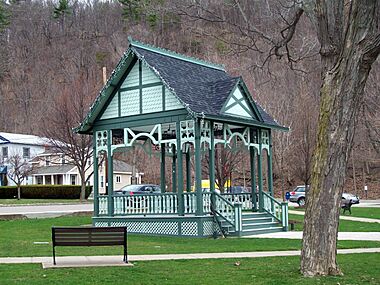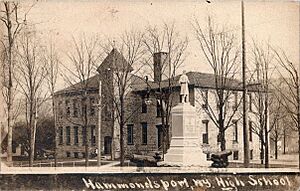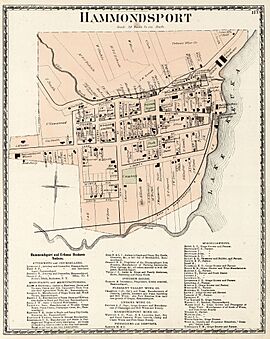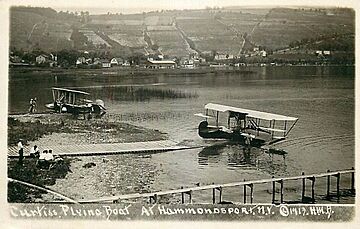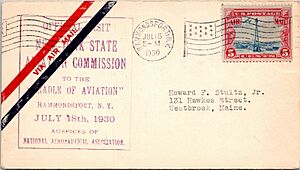Hammondsport, New York facts for kids
Quick facts for kids
Hammondsport, New York
|
|
|---|---|
|
Village
|
|

Village of Hammondsport
|
|
| Country | United States |
| State | New York |
| County | Steuben |
| Town | Urbana |
| Area | |
| • Total | 0.37 sq mi (0.96 km2) |
| • Land | 0.35 sq mi (0.91 km2) |
| • Water | 0.02 sq mi (0.05 km2) |
| Elevation | 761 ft (232 m) |
| Population
(2020)
|
|
| • Total | 583 |
| • Density | 1,665.71/sq mi (642.88/km2) |
| ZIP code |
14840
|
| Area code(s) | 607 |
| GNIS feature ID | 2390879 |
Hammondsport is a small village in Steuben County, New York. It's located at the southern end of Keuka Lake, one of the beautiful Finger Lakes. People first settled here in 1792.
The village started to grow in the 1790s, with buildings like a courthouse and a jail. In the 1850s, vineyards and the wine industry began to thrive around Hammondsport. Glenn Curtiss, a famous aviation pioneer, was born here. He built many aircraft, including the first seaplanes, which he tested on Keuka Lake.
Today, Hammondsport has a village square, historic buildings, wineries, breweries, and museums. Nearby areas are known for their vineyards and grape-packing businesses, which are very important to the local economy. Some buildings around Pulteney Square are part of the Pulteney Square Historic District and are listed on the National Register of Historic Places.
Contents
History of Hammondsport
Hammondsport was first settled in 1792 by Samuel Baker, Mr. Aulls, and Captain Amos Stone. It was first called "Cold Spring Valley" because of a very cold spring that flowed into Keuka Lake. It was also known as Pleasant Valley.
In 1802, General George McClure bought land south of Hammondsport. He built mills for sawing wood, making flour, and processing wool. He also opened a store in Hammondsport, which helped start businesses there. The village was later named after Lazerus Hammond, who arrived in 1810. Hammond officially founded the village around 1826, and it became an official village in 1856. Hammondsport soon became a major center for New York's wine industry.
The first Christian church service in Hammondsport was held in 1825 by Reverend Bostwick. Other churches were later established in the 1830s.
The Wine Industry
Reverend Bostwick planted the first grapevines in his garden in 1830. He soon realized that the area around Keuka Lake was perfect for growing grapes. This led to the start of the wine industry in the western Finger Lakes region.
By 1852, grapes from vineyards around the lake were being shipped by boat to Hammondsport. From there, they went by wagon to the Bath & Hammondsport Railroad. This railroad connected to the Erie Railroad at Bath, allowing grapes to be sent to New York. This greatly helped the wine industry grow. The Bath & Hammondsport Railroad operated for 120 years.
By 1870, Hammondsport had 3,000 acres of vineyards. This grew to 14,500 acres by 1889. Because of this, Hammondsport is seen as the heart of New York's grape-growing region.
The Crooked Lake Canal was finished in 1833. It connected Hammondsport to the Erie Canal. This meant goods could be shipped by boat between Hammondsport and New York City. However, when the Bath and Hammondsport railroad opened in 1874, the canal was no longer needed and closed in 1877.
Village Life and Growth
The first school in Hammondsport was built in 1827. In 1858, a private academy opened. This building later became the Hammondsport school until 1935.
Mallory Mill was built in 1836. This large stone building was used as a grist mill, grinding grain. Later, it became a warehouse and then a winery. It is now listed on the U.S. National Register of Historic Places.
Many important people lived and worked in Hammondsport. The first village officers were elected in 1856. Hammondsport also had its own newspapers, like the Hammondsport Advertiser (first published in 1838) and the Hammondsport Herald (first published in 1874).
The Saint James Episcopal Church was built in 1895. It replaced two earlier churches.
In 1894, Hammondsport got its first water system. Pure spring water came from Mt. Washington. This system also helped provide water for fire hydrants in the village.
In 1917, the first telephone office was built. This was important for the growing businesses, especially the Curtiss Manufacturing Company.
Steamboats on Keuka Lake
Hammondsport's location on Keuka Lake made it a busy place for boats. Docks here welcomed vessels that carried people and goods between Hammondsport and Penn Yan. The first boat on Keuka Lake was The Sally, built in 1808. It carried wheat and other goods.
By 1835, several steamboats were running on Keuka Lake. The first was the Keuka Maid. Later, Hammondsport became home to steamboat builders. The Mary Bell, built in 1892, was the largest steamboat on the lake.
However, by 1921, cars and trucks became more popular. Large boat traffic on the lake was no longer profitable. The Mary Bell was the last big vessel to travel between Hammondsport and Penn Yan.
In the 1850s, farming became less important as the Erie Railroad arrived. But grape growing, or viticulture, became a new and promising industry. The climate and soil around Keuka Lake were perfect for grapes. The Pleasant Valley Wine Company was the first vineyard in the area. French winemakers also brought new types of grapes.
Hammondsport During the Civil War
During the American Civil War, young men from Hammondsport volunteered to serve. They joined Company G of the 107th New York Infantry Regiment.
Morris Brown, Jr., who once lived in Hammondsport, received the Medal of Honor. This was for his brave actions at the Battle of Gettysburg, where he captured a Confederate flag. He died in action later in Virginia.
Early 20th Century Changes
By 1914, Hammondsport was a busy village. It had many wineries, hotels, stores, and other businesses. It also had the airplane factory of the Glenn Curtiss Company.
However, Prohibition (1919-1933) greatly affected Hammondsport. Many wineries had to close, leading to job losses. This also hurt the Bath & Hammondsport Railroad, which used to carry a lot of wine and grapes.
Aviation Development
Hammondsport was a very important place for aviation (airplane) development in the early 1900s. Glenn Curtiss, a famous airplane designer, was born here in 1878. He developed aircraft that could take off and land on water.
Curtiss started a bicycle shop in Hammondsport, which became very successful. He then developed his own gasoline engine. This success helped "put Hammondsport on the map." Glenn became an expert in gasoline engines and later designed motorcycles and aircraft.
In 1904, Curtiss started working with Thomas Scott Baldwin, a balloon pioneer. They built a factory in Hammondsport to make balloons and dirigibles (blimps).
Curtiss built early airplanes and seaplanes in his Hammondsport factory. He also joined with Alexander Graham Bell to form the Aerial Experiment Association. On July 4, 1908, Curtiss flew the June Bug for over 1 kilometer from the Hammondsport airfield. This was the first American airplane to do so. The June Bug was later fitted with floats and became the first aircraft to take off and land on water.
In July 1912, the first successful flight of a "flying boat" happened in Hammondsport on Keuka Lake. The first long-distance "flying boat," the America, was also designed by Curtiss and launched here in 1914.
In 1911, Curtiss started the first flying school in America in Hammondsport. He taught Blanche Stuart Scott how to fly, and she became America's first female pilot.
Henry Kleckler, a native of Hammondsport, was Curtiss's shop foreman. He was a "master innovator" and helped Curtiss develop better engines for the "flying boats."
On May 19, 1908, Thomas Selfridge, working with Curtiss, became the first U.S. military officer to pilot a modern aircraft. He flew the White Wing from Keuka Lake. Sadly, he later died in a plane crash while working with Orville Wright.
Glenn Curtiss died in 1930 at age 52. His funeral was held in Hammondsport. Today, the Glenn H. Curtiss Museum is located near Hammondsport. It displays many of Curtiss's airplanes and other inventions.
The Great Flood of 1935
In July 1935, very heavy rains caused major flooding in southern-central New York. Hammondsport was hit especially hard, with over 8 inches of rain in just two days. Water rushed down the hills and through Glen Brook, which flows next to the village.
The powerful water broke stone walls, carving channels through roads. The flood killed seven people, including five children. Many homes and buildings were damaged or ruined. The flood also destroyed a warehouse, releasing hundreds of barrels of brandy into the streets. The railroad line to Bath was almost completely destroyed. After the flood, the stone walls along Glen Brook were made wider and stronger with concrete to prevent future floods.
Geography and Location
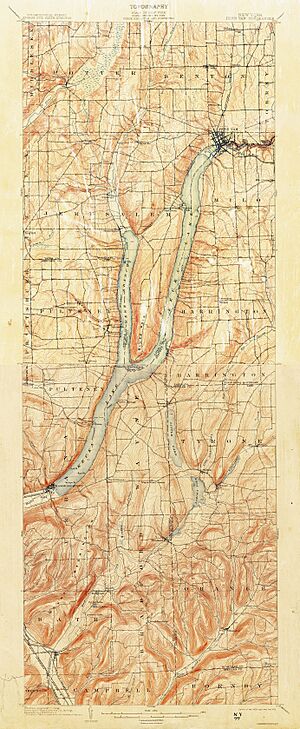
Hammondsport is located at the southern end of Keuka Lake. It sits at the bottom of one of the long hills that form the Keuka Lake valley. The village is near where New York State Route 54 and New York State Route 54A meet. Keuka Inlet and Glen Brook flow through the village.
Population Facts
| Historical population | |||
|---|---|---|---|
| Census | Pop. | %± | |
| 1870 | 602 | — | |
| 1880 | 755 | 25.4% | |
| 1890 | 934 | 23.7% | |
| 1900 | 1,169 | 25.2% | |
| 1910 | 1,254 | 7.3% | |
| 1920 | 1,060 | −15.5% | |
| 1930 | 1,063 | 0.3% | |
| 1940 | 1,112 | 4.6% | |
| 1950 | 1,190 | 7.0% | |
| 1960 | 1,176 | −1.2% | |
| 1970 | 1,066 | −9.4% | |
| 1980 | 1,065 | −0.1% | |
| 1990 | 929 | −12.8% | |
| 2000 | 731 | −21.3% | |
| 2010 | 661 | −9.6% | |
| 2020 | 583 | −11.8% | |
| U.S. Decennial Census | |||
According to the 2020 census, 583 people live in Hammondsport. In 2000, there were 731 people and 332 households. About 27% of households had children under 18. The average age in the village was 42 years old.
Famous People from Hammondsport
- Morris Brown, Jr. – A hero who received the Medal of Honor during the American Civil War.
- Glenn Curtiss – A pioneer in aviation, born in Hammondsport in 1878.
- Charles Champlin – A film critic and writer, born here in 1926.
- Joseph M. Champlin – A Roman Catholic priest and author, born here in 1930.
- John Randolph Kuhl – A former Congressman and state politician, who lives in Hammondsport.
- Meredith Mallory – A former Congressman.
More About Hammondsport
Some important historical places in Hammondsport are listed on the National Register of Historic Places. These include the Hammondsport Union Free School, Mallory Mill, and the Pulteney Square Historic District.
The 1995 movie Dadetown was filmed in and around Hammondsport.
See also
 In Spanish: Hammondsport para niños
In Spanish: Hammondsport para niños



